New York borders two of the Great Lakes, Lake Ontario, and Lake Erie. It also has a coastline along the Atlantic Ocean and the Long Island Sound. Scattered throughout the state are many small and good-sized lakes including the Finger Lakes which are popular vacation spots.
Lake Champlain, an enormous lake on the New York-Vermont border, is one of the largest lakes in the US running 120 miles long. But which one of these lakes is the deepest? Sometimes smaller lakes are actually deeper than larger ones.
Let’s find out about the deepest lakes in New York.
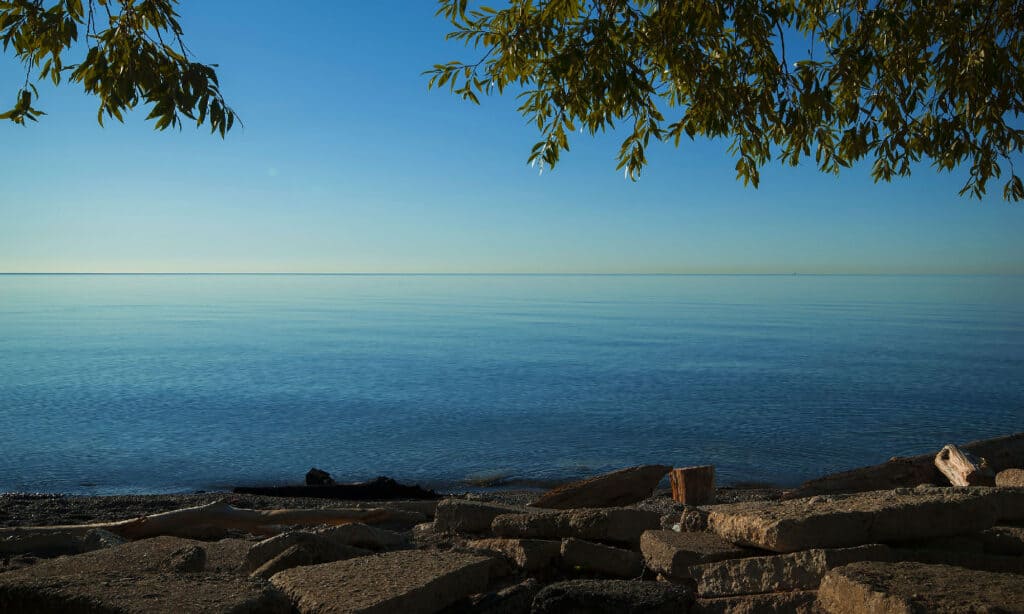
Lake Ontario is the smallest Great Lake
©Michael J. Eves/Shutterstock.com
What is the Deepest Lake in New York?
Lake Ontario takes the title of the deepest lake in New York. Although it is the smallest of the Great Lakes, it is deeper than Lake Erie and Lake Huron. Lake Ontario is along the northwest border of New York. The city of Rochester, NY is on the south shore of the lake and the deepest point is north of the city in the Rochester Basin. Several beaches in Rochester, like Ontario Beach Park, have sandy beaches, fishing piers, and boat ramps.
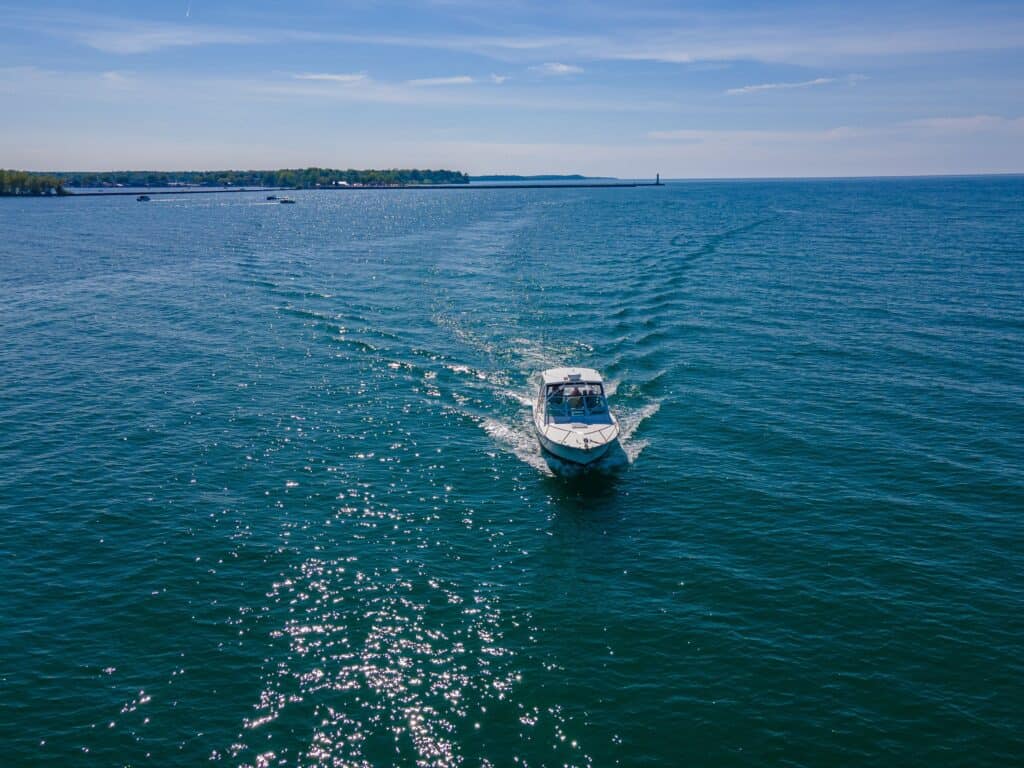
The deepest lake in New York is Lake Ontario at 802 feet.
©Wirestock Creators/Shutterstock.com
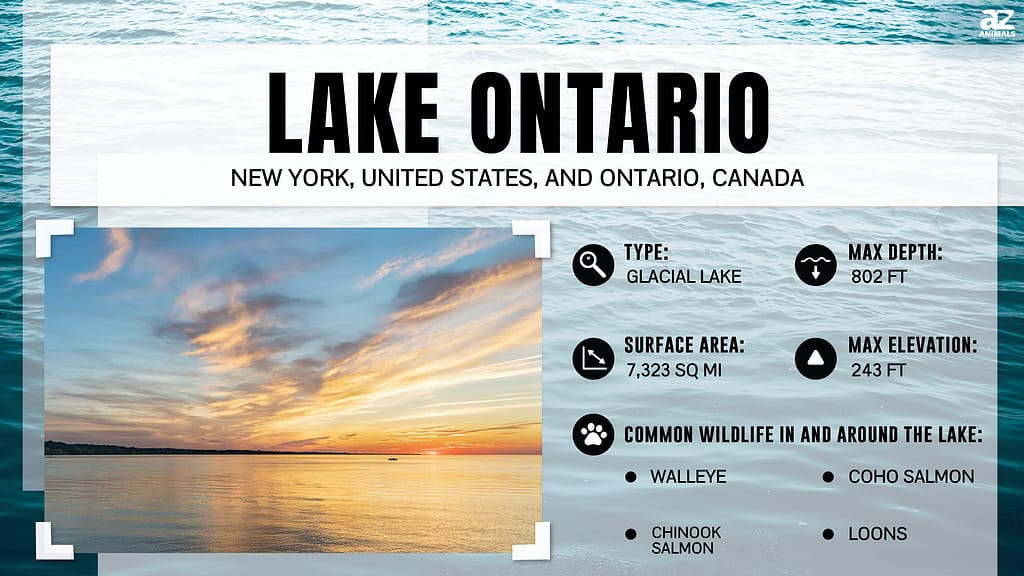
Where Is Lake Ontario Located on a Map?
Lake Ontario sits astride the borders of New York and Ontario, north of Buffalo, Rochester, and Syracuse. Toronto, Mississauga, and Kingston sit on its western and northern shores. The lake which is an ideal location for recreational fishing is also the smallest of all the Great Lakes in terms of its surface area.
How Deep is the Deepest Lake in New York?
Lake Ontario has an average depth of 283 feet but at its deepest point, it reaches 802 feet. If you were standing on the 80th floor of a skyscraper and looked down, that is around 800 feet. Lake Erie, which also borders New York, is only 210 feet at its deepest spot. The deepest Great Lake is Lake Superior with the maximum depth being 1,332 feet!
Lake Ontario vs. Lake Seneca
| Lake Ontario | Lake Seneca | |
| Depth | 802 Feet | 618 Feet |
| Width | 53 Miles | 1.864 Miles |
| Length | 193 Miles | 38 Miles |
| Lake Region in NY | Great Lakes | Finger Lakes |
How Deep is the Deepest Inland Lake in New York?
The deepest inland lake in New York is Seneca Lake, one of the Finger Lakes. Located in Western New York the Finger Lakes are a series of long skinny lakes. When we say long we mean miles! Seneca Lake is 38 miles long with the city of Geneva on the north shore and Watkins Glen on the south shore. At the deepest point, Seneca Lake is 618 feet deep. This makes it the deepest lake entirely contained in New York.
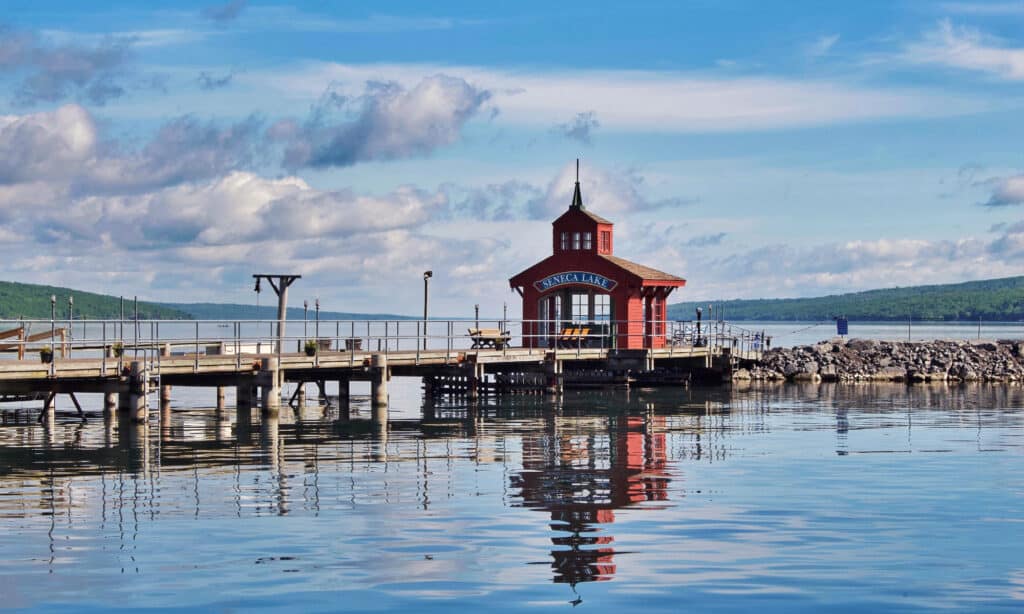
Seneca Lake, New York is the deepest inland lake in the state at 618 feet.
©Nova Optics/Shutterstock.com
Are there Shipwrecks at the Bottom of Seneca Lake?
Yes! With a grant from the NYS Parks Historic Preservation Office and the NYS Canal Corp, a team of researchers used sonar to explore the bottom of the lake. In June 2019, Thomas Manley and Art Cohn led the team on a two-week survey looking for shipwrecks. On their first day out they found several shipwrecks, some of which still have their cargo intact. A previous survey years before documented eight ships and the new survey found six more, making the total fourteen ships at the bottom of Seneca Lake.
Did they Sink a Paddlewheel Steamer on Purpose?
Yes. Back on September 14, 1898, the owners of the Onondaga, a large paddlewheel steamer, decided to retire the older boat. They wanted to do it with style and proposed they blow it up with grand fanfare and sink it in Seneca Lake. Sinking an old or unrepairable ship is called scuttling.
According to the papers at the time, 5,000 people showed up to watch the boat be dynamited and sink. The crowd was reportedly disappointed when the ship sank so fast it went under before the smoke even cleared so they didn’t get to watch a slowly sinking ship.
Researchers later found just the outline of the hull with sonar equipment at about 400 feet deep. They devised the rest of the boat had been completely blown up. Unfortunately, the effects of this “stunt” were before modern conservation times because piles of dead fish washed up on shore for the next few days after the explosion.
What kind of Fish Live in Seneca Lake?
The main fish in Seneca Lake are lake trout, yellow perch, and smallmouth bass. The lake is stocked with hatchery-reared brown trout, lake trout, and landlocked salmon making it a popular place for fishing. Other fish that live in Seneca Lake are northern pike, rock bass, and bluegills. Unfortunately, there are also sea lampreys in Seneca Lake.

Lake trout is a common fish found in Seneca Lake.
©iStock.com/LaSalle-Photo
These invasive species are parasitic and attach themselves to healthy fish and kill them. One look at a sea lamprey and you will understand why environmental officials are trying to eliminate them from the Finger Lakes and the Great Lakes system.

Sea lamprey on brown trout, facing left
©Sweeting, Roger [Photographer] (2016) Sea lamprey parasitising brown trout. Freshwater Biological Association, UK / Creative Commons – License
Are there any Fishing Records from Seneca Lake?
No. Although the fishing is excellent in Seneca Lake, none of the fish caught have been record-breaking fish…yet!
Are there any Fishing Records from Lake Ontario?
Yes! Big lake…big fish! Several of the fishing records in New York have been pulled from Lake Ontario. Here are some of the record-breaking fish caught off the New York coast on Lake Ontario:
- Atlantic Salmon: 24 pounds 15 ounces, Mike Dandino
- Brown Trout: 33 pounds 2 ounces, Tony Brown
- Burbot (cod-like fish): 16 pounds 12 ounces, Terrance Colwell
- Coho Salmon: 33 pounds 7 ounces, Stephen Sheets Jr.
- Rainbow Trout: 31 pounds 3 ounces, Robert Wilson
How Deep is the Long Island Sound?
The deepest spot in the Long Island Sound is 350 feet deep. The deepest part of the sound is the eastern part, whereas the central section averages 65 feet, and as you move westward it gets even shallower to 20 feet and below.
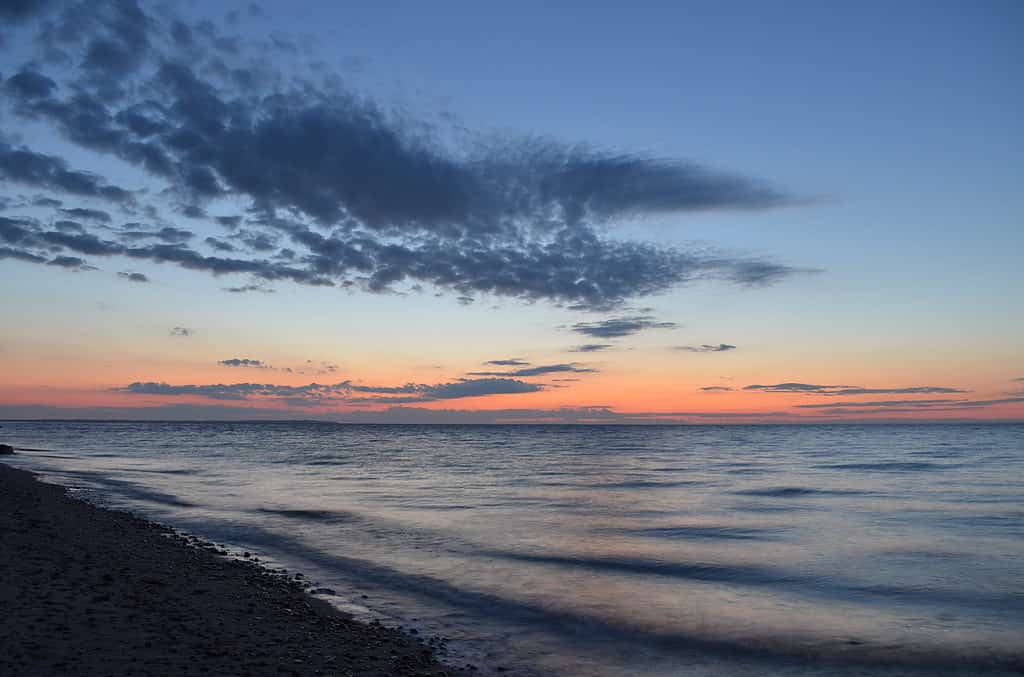
The Long Island Sound is 350 feet deep at the deepest spot.
©AYIGITB/Shutterstock.com
How Deep is the Atlantic Ocean?
The Atlantic Ocean is 27,493 feet deep at its deepest point. Off the shores of New York, the Atlantic Ocean Basin is closer to 65 feet (20 meters). The deepest spot of the Atlantic Ocean is north of Puerto Rico in what is called the Puerto Rico Trench. If you compare that to Lake Ontario which is 802 feet deep you get an idea of how vast the ocean is.
How does the Deepest Lake in New York Compare to the Deepest Lake in the U.S.?
The deepest lake in New York is 802 feet deep, Lake Ontario. The deepest lake in the U.S. is 1,943 feet deep! That makes it 1,141 feet deeper. Crater Lake in southern Oregon is the deepest lake in the U.S. What is crazy about Crater Lake is that it sits inside a collapsed volcano. There are no rivers or streams running into it, all the water comes from rain and snow. That is how it gets its crystal-clear blue coloring.
The National Park Service which manages the lake and the Crater Lake National Park establishes rules to make sure the lake stays clear and free of invasive species. There is only one access point to the lake and activities like canoeing, kayaking, snorkeling, and scuba diving are prohibited.
Fishing is allowed but there are only two species of fish that inhabit Crater Lake. Years ago Kokanee salmon and rainbow trout were introduced to the lake and they continue to have healthy populations in the lake.
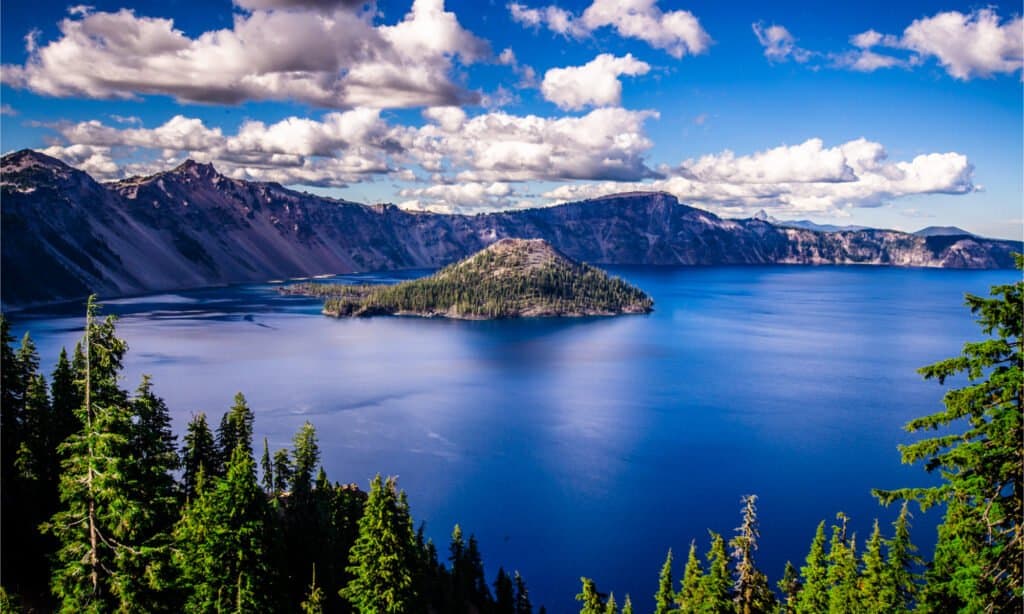
Crater Lake in southern Oregon is the deepest lake in the US with a maximum depth of 1,943 feet.
©Pung/Shutterstock.com
Can you Swim in Crater Lake?
You are allowed to swim in Crater Lake but when you find out the average temperature of the surface water in summer is 55°-60° you might decide it’s not for you. For reference, your average swimming pool is 77°-82°, so 55° is downright chilly! If you measure the temp deeper in the lake, the average temp below 300 feet is 38°. Not quite freezing but close.
The photo featured at the top of this post is © iStock.com/KvitkaNastroyu
Sources
- Britannica, Available here: https://www.britannica.com/place/Lake-Ontario
- Department of Environmental Conservation, Available here: https://www.dec.ny.gov/outdoor/25574.html
- Department of Environmental Conservation, Available here: https://www.dec.ny.gov/outdoor/7935.html
- National Park Service, Available here: https://www.nps.gov/crla/faqs.htm
- Britannica, Available here: https://www.britannica.com/place/Atlantic-Ocean
Thank you for reading! Have some feedback for us? Contact the AZ Animals editorial team.






